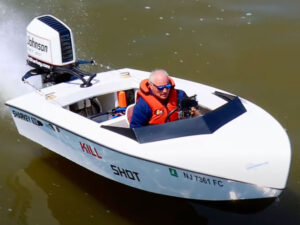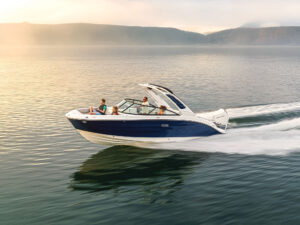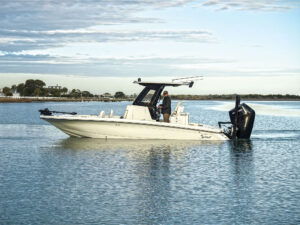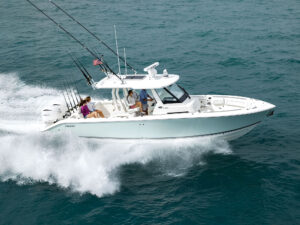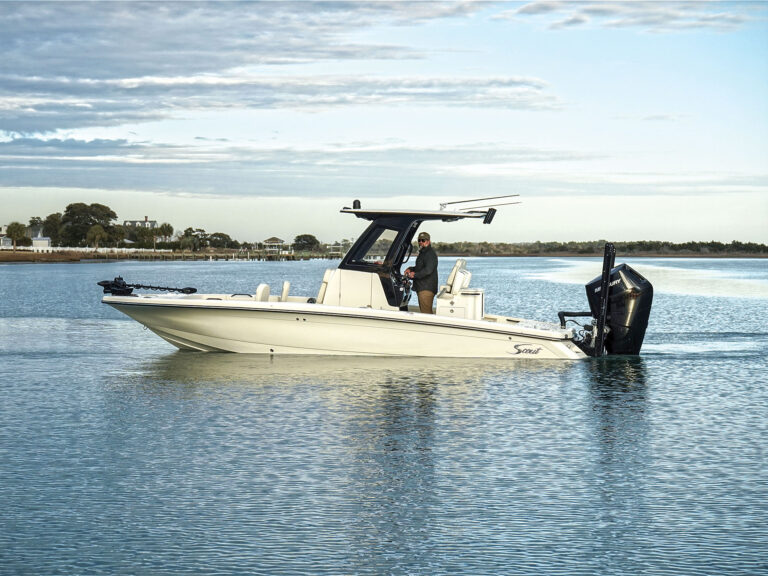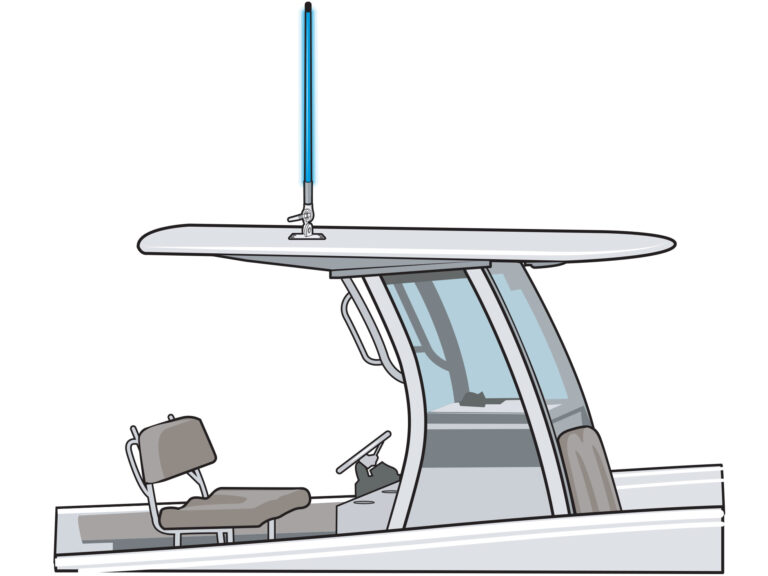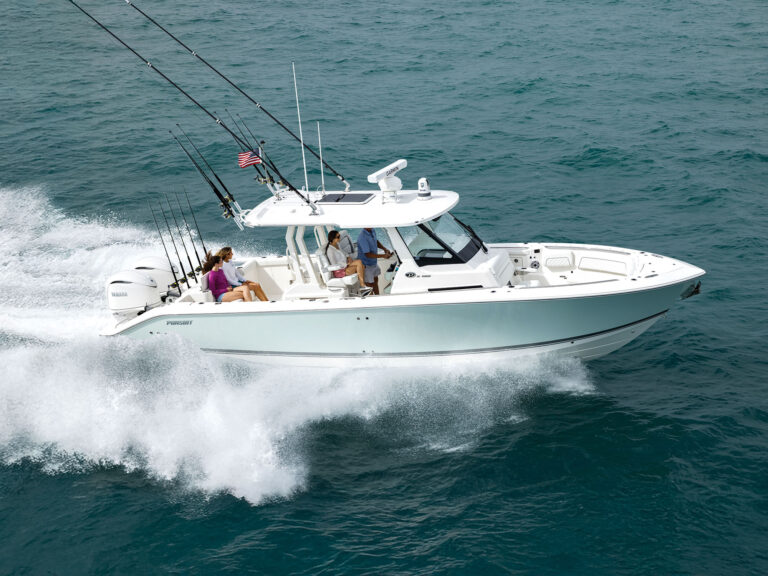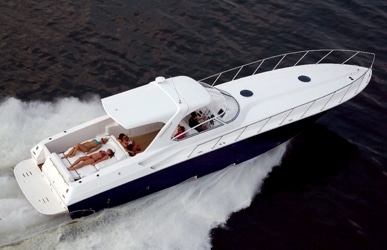
boatingjul23shoot3871
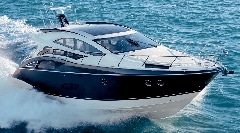
boatingjul23shoot3872
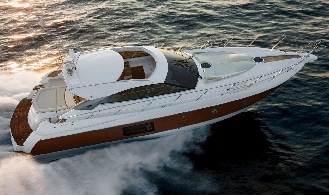
boatingjul23shoot3873
With the popularity of pod drives, express yacht owners have more choices than ever. I found three, each with a different propulsion system-pods, surface drives, and inboards. The best news? They all top 40 mph. Pods let newcomers dock the boat with a joystick as if they were playing a videogame. Surface drives can be trimmed, which offers better performance and versatility. Traditionalists prefer the familiar straight inboard and argue that the addition of a bow thruster provides the captain with maneuverability that’s comparable to pod drives.
Fountain 48 Express Cruiser, www.fountainpowerboats.com 252-975-2000
The Basics
LOA: 51’0″
Beam: 12’0″
Draft: 3’10”
Displacement (lbs., approx.): 24,000
Tansom deadrise: 22°
Bridge clearance: 9’10”
Max. cabin headroom: 6’4″
Fuel capacity (gal.): 470
Water capacity (gal.): 80
Price (w/twin 480-bhp Cummins QSB5.9-480 diesels w/Arneson surface drives): $881,819
Details: The redesign of the 48 Express Cruiser’s interior gives the boat a more contemporary appeal. In the cockpit, the bench seat bottom cushion rises on a hydraulic jack to create a large sunlounge with a huge locker beneath it. The cockpit wetbar is cleverly designed, and the helm arrangement is well thought out. By putting the trim switches ahead of the portside throttles, your right hand always remains on the wheel. Belowdecks, two adults would be comfortable in the midcabin, and the forward master and guest head rival their European counterparts.
Contruction: This is performance-oriented construction with stringers formed out of Coosa composite panels encapsulated in fiberglass, Divinycell foam coring in the hull bottom, sides, and deck, and quad-directionally woven fiberglass with vinylester resin. It’s a lighter boat compared to the competition. It’s also 2′ narrower. Fountain bonds the hull-to-deck joint with Plexus adhesive and seals it with fiberglass tabbing around the perimeter. Rigging is also race-style with the engines mounted on aluminum L-angles through-bolted to the stringers. The compartment is laid out cleanly and with performance in mind with the genset on the centerline and the batteries low.
Performance: As if the performance advantage (including a 51.6-mph top speed) with a pair of engines isn’t enough, you can get the twin-stepped 48 Express Cruiser with triple 480-bhp Cummins engines and Arneson drives ($972,727), which push the boat to 63 mph. The twin-engine version I tested planed easily at 18 mph with the engines turning 1950 rpm. If you get caught in rough water, keep the drives trimmed in and you still can make good headway. Of course, in smooth conditions, lean on the sticks and you’ll pull away from virtually any other boat in this class. During maneuvers, it feels like a sportboat.
Highs & Lows
Highs: Arneson surface drives give the boat versatility, not to mention a big edge in top speed when teamed with twin-stepped bottom. Improved styling and interior design make the boat competitive with traditional yachts. Engine compartment layout is easy to work with. Cool convertible sunlounge.
Lows: Don’t like circuit breakers in base of cockpit sink cabinet. White finish on dash panel causes some harsh glare. Midcabin needs some natural ventilation.
Marquis 50 Sport Coupe, www.marquisyachts.com 920/822-1575
The Basics
LOA: 49’6″
Beam: 15’7″
Draft: 3’9″
Displacement (lbs., approx.): 44,500
Tansom deadrise: 16.5°
Bridge clearance: 16’0″
Max. cabin headroom: 6’6″
Fuel capacity (gal.): 506
Water capacity (gal.): 90
Price (w/triple 435-bhp Volvo Penta D6 IPS 600 in-line-6 diesel tractor drives): $1,148,700
Details: The most futuristic looking of our trio, the 50 Sport Coupe has lines that make you stop and stare. Inside, the cockpit has a large aft lounge with plenty of space to move around the adjustable table. You’d want to stock the wetbar with the optional icemaker ($2,810), refrigerator ($2,810), and grill ($2,240) for entertaining. Skippers will appreciate the adjustable seat at the portside helm. The highlight, of course, is the IPS joystick. The salon-level galley is appropriately equipped. The aft VIP stateroom with a queen berth has access to the day head, and the spacious master quarters has a true luxury-suite-style feel.
Construction: Marquis is the only yacht line built in the U.S. with Class A certification in Europe, which means it can withstand 40-knot winds and seas up to 13′. It’s constructed with a unique 3D mold. Instead of pulling the piece out of the molds, sections of the mold pull away from the hull and deck. The hull bottom is solid fiberglass, and the sides are cored with foam below the waterline and balsa above. Stringers are also cored with foam. Aluminum reinforcements support the deck and pilothouse. Engines are installed with a through-bolted rail system. Onboard drains run into a single manifold before dumping overboard at a single outlet.
Performance: The 50 SC was the first express yacht to use triple IPS drives. Marquis chose it to get the boat to top 40 mph-49.2 mph to be exact. The boat was designed for the propulsion system with retractable 15″-long horizontal planes across the transom. Lower them and they keep the boat from getting into that high bowrise (7 degrees or so) that many pod-driven hulls experience at midrange levels. Handling at speed was crisp. With joysticks, the trio of engines/drives can make the boat dance around the docks. Also, you can run the boat on only two engines. With one motor disengaged it hit 28.2 mph, burning 20 gph.
Highs & Lows
Highs: Great maneuverability and efficiency with the triple IPS package. The propulsion choice also makes for a tidier engine compartment. Extendable cockpit makes the boat feel more like a 55-footer. Wide passageways facilitate the trip forward on deck.
Lows: Footrest at helm should be hinged. Needs a gas strut or retaining cable to keep anchor locker hatch from lying over on top of windlass. More stowage for small items in master stateroom would be helpful.
Sessa C52, www.sessamarine.com 954-925-2955
The Basics
LOA: 52’0″
Beam: 14’7″
Draft: 3’10”
Displacement (lbs., approx.): 36,000
Transom deadrise: 16°
Bridge clearance: 18’6″
Max. cabin headroom: 6’5″
Fuel capacity (gal.): 528
Water capacity (gal.): 158
Price (w/twin 775-bhp Volvo Penta D12-800 in-line-6 diesel inboards): $1,159,000
Details: The C52 is set up best for long-tem cruising, with a tender garage and sleeping room for six. The large sliding sunroof opens to let in ample natural light to warm everyone seated on the portside lounge. There’s a smaller seat to starboard around the cocktail table. The wetbar comes standard with a refrigerator and stove. A clean helm layout is finished in glare-cutting tan. Belowdecks, the sleeping arrangement has two longitudinal berths in the aft starboard stateroom with a full-sized bed in the cabin to port that has access to the day head. The forward master and day heads both have standup showers. A portside galley is well equipped.
Construction: Following conventional construction techniques, Sessa lays up the C52 with a solid fiberglass bottom, and the sides and deck are cored with foam. Ditto for the stringers and bulkheads. To reduce stress on the front of the top section of the windshield and pilothouse, the glass is thicker and helps support the structure. In the engine compartment, substantial aluminum mounts are through-bolted to the sides of the stringers and bolted into tapped aluminum plates in the tops of the bearers. Accessories in the forward section of the compartment can be easily checked, but clearance diminishes as you head aft beneath the garage.
Performance: There’s no better way to know how a boat handles rough water than to actually run in it. My test conditions served up seas that averaged 3′ with 6-footers popping up at regular intervals. We made good headway at 21 mph and 1700 rpm. I used only a little negative trim on the tabs to keep the ride level, and it remained rattle- and shudder-free. It weighs 8,500 pounds less than the Marquis, has a shallower deadrise than both competitors, is devoid of big prop tunnels, and runs a competitive 41.3 mph. Handling was predictable.
Highs & Lows
Highs: This is a boat you want in bad seas. The small stowage tray forward of driver’s feet is perfect for cell phone or wallet. Only boat of the three with eye-level stowage lockers in master stateroom and the only one with a garage.
Lows: Watch your head as you walk between the two berths in the aft cabin. Same goes for the engine compartment beneath the garage. Fiddle the stainless-steel countertop in galley. Anchor locker needs a chainbox.
The Bottom Line: Experienced cruisers who want extra sleeping capacity and tender stowage will favor the traditional look and build of the Sessa C52. Owners stepping into their first larger boat will love the ease of handling and docking that the IPS drives and a joystick deliver in the Marquis 50. But the best combination of performance, fuel economy, price, and comfort-thanks to its updated, contemporary interior design-is delivered by the Fountain 48.

